Bridging the Age Divide: Strategies for Combating Ageism in Today’s Job Market
- Home
- Bridging the Age Divide: Strategies for Combating Ageism in Today’s Job Market

- Editors Desk
- January 24, 2024
- 0 Comments
In the dynamic labyrinth of today’s job market, ageism remains a subtle serpent, often camouflaged amidst the bright veneer of modern workplace culture. As an Ethical Business Leader, I’ve witnessed the ways in which older workers are systematically marginalized. It is imperative to confront the silent yet pervasive age bias—both overt and subtle—that taints hiring practices, promotions, and the holistic work environment. Not only does this prejudice affect mature professionals, but it also profoundly hampers the companies that fail to harness the depth of experience and wisdom these individuals offer.
The subtle forms of ageism may manifest in seemingly benign preferences for ‘digital natives’ or job postings seeking ‘fresh, young talent.’ Overt discrimination includes setting arbitrary age limits for applicants or overlooking seasoned professionals for upskilling opportunities. These biases erect invisible barriers, segregating a segment of the workforce that is rich with industry knowledge, adaptability, and refined skill sets.
One cannot ignore the symbiotic relationship between worker and workplace. When companies undervalue seasoned employees, they overlook a treasure trove of insight and leadership potential. This myopic viewpoint squanders opportunities for innovation and corporate growth, as diverse age representation ensures a broader perspective, ultimately nurturing a more robust decision-making process.
To rectify this imbalance, employers and employees alike must embrace actionable steps. Companies can start by auditing their hiring practices to eliminate ageist language and ensuring that job requirements genuinely reflect the demands of the position, rather than the perceived capabilities associated with age. Implementing blind recruitment processes can also mitigate bias, allowing candidates to be evaluated on their merits alone.
Furthermore, establishing intergenerational mentorship programs reaps dual benefits. They facilitate knowledge transfer and foster mutual respect across age groups. Lifelong learning opportunities signal to all employees that growth is an infinite journey, not confined by the number of years one has lived.
Admirable are those entities that have blazed trails in this realm. Take, for example, a technology firm that launched a ‘Returnship’ program, offering training and mentorship to professionals reentering the workforce after a career hiatus. This initiative led not only to a surge in employee morale but also a notable uptick in productivity and innovation, painting a vivid picture of the symbiotic relationship between age diversity and business success.
Let us then also discuss corporate policies that support a diverse age range within the workforce—policies such as flexible scheduling, retirement transitioning, and health benefits tailored to a multigenerational staff. It is these forward-thinking practices that serve as the bedrock for an inclusive environment.
It is incumbent upon industry leaders, HR professionals, and workers of all ages to take a stand against this form of discrimination. We must collectively strive to champion a job market that values talent and experience over the superficial metric of age.
I conclude with a call to action: let us join hands in dismantling the barriers of ageism and cultivate a garden where every employee, regardless of the year on their birth certificate, can bloom to their full potential. Together, we can redefine the corporate ecosystem to one that truly embodies diversity, equity, and inclusion. The time to act is now, to ensure a future where the marketplace of jobs is as rich and varied as those who populate it.

Leave A Comment